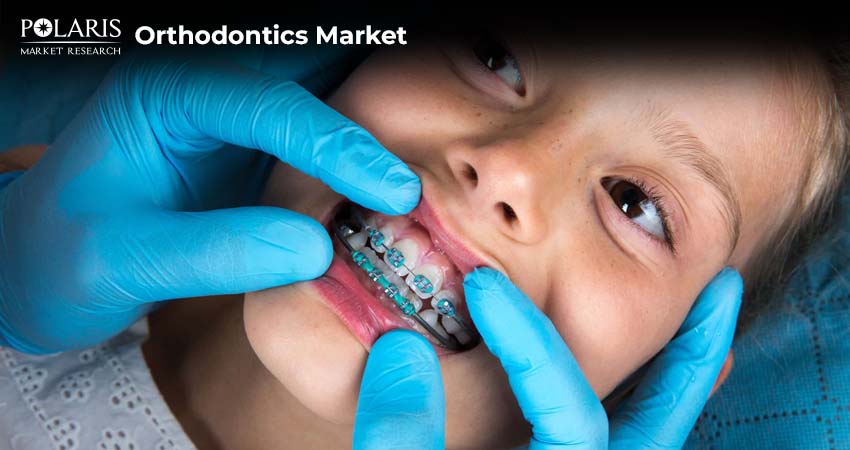Why Is Orthodontic Care About More Than Just Appearance?

There’s more to a smile than it meets the eye. It’s a reflection of overall well-being and confidence. Beyond just looking good, a healthy and bright smile can have a significant impact on an individual’s self-esteem, social interactions, and overall health.
But for many individuals, their teeth aren’t quite as straight as they would ideally like. Crooked teeth, gaps, crowding, or bite issues are common concerns that can affect both the function and appearance of the smile. And that’s where orthodontics comes in.
In this blog post, we take you to the fascinating realm of orthodontics, explaining to you its basics and working. Also, we’ll detail the most common orthodontics treatment types and shed light on why the orthodontics market is growing rapidly. Stick with us!
Understanding Orthodontics
Orthodontics is a specialized branch of dentistry that focuses on aligning teeth and jaws. It addresses misalignments like crooked or overlapping teeth. It also helps with problems with the bite. Orthodontics often uses appliances like braces or clear aligners to move teeth into their desired position. It may also involve jaw surgery and palatal expansion techniques to address various malocclusions.
Working of Orthodontics Treatment Explained
Here’s how the orthodontics treatment typically looks like:
Initial Consultation: This is the first step of the orthodontics treatment process. Here, the orthodontist carries out a detailed examination of the individual’s teeth and jaw. That way, they can determine the best course of treatment for the individual.
Preparatory Work: Preparatory work may involve taking dental X-rays or making teeth impressions to develop a detailed map of the individual’s mouth. 3D imaging can also be used to obtain an accurate view of the teeth and facial structure. If there’s a significant misalignment between one or more teeth, the orthodontist may suggest teeth removal to the use of special appliances to improve the bite.
Braces: Once done with the preparatory work, the orthodontist will place the braces in the individual’s mouth. Necessary adjustments concerning comfort and effectiveness will also be made. This typically lasts for several months and needs regular follow-up visits for adjustments.
Follow-Up Visits: During follow-up visits, the orthodontist will check the progress of your braces. Here, any necessary adjustments will also be made.
Retention: After the treatment is completed and the braces are removed, the individual is given a retainer to wear. The use of a retainer helps keep the teeth in their position.
Orthodontics Treatment Market in Numbers
With rising disposable income, people are allocating more funds for healthcare and overall well-being, including orthodontic care. In addition, the geriatric population is significantly driving the demand for orthodontics treatment as it helps address several issues, including misalignment, tooth loss, and jawbone deterioration, experienced by older adults.
According to our latest analysis, the orthodontics market is anticipated to register sustained growth in the coming years. The study analyzes the market to register a compound annual growth rate (CAGR) of 10.6% during 2025–2034. The market was valued at USD 7.40 billion in 2024 and is projected to grow to USD 20.18 billion by 2034.
Common Orthodontics Treatment Options Listed
Here’s a look at some of the most common types of orthodontics treatment options:
Traditional Metal Braces: Traditional metal braces are one of the most commonly used and highly effective treatments for several orthodontics issues. They encompass metal brackets that are bonded to each tooth using dental equipment. These brackets are connected by an archwire that gradually shifts the teeth into their desired position. Metal braces are valued for being durable and affordable, though some may find them less aesthetically pleasing.
Clear Ceramic Braces: The function of clear ceramic braces is similar to that of metal braces. But instead of metal brackets, ceramic braces make use of clear or tooth-colored brackets. Their ability to blend in better with the natural teeth makes them appealing to individuals concerned about the appearance of braces. However, clear ceramic braces are somewhat more fragile than their metal counterparts.
Self-Ligating Braces: These braces leverage a built-in mechanism in the bracket to hold the archwire in place. This is in contrast to traditional braces that use elastic bands or metal ties. This design results in less friction and potentially a faster and more comfortable treatment.
Lingual Braces: The purpose of lingual braces is the same as that of traditional braces. But instead of bonding them on the front, these braces are placed behind the teeth. That way, they are virtually invisible from the front. However, lingual braces may be more expensive as compared to other options. Also, they may need some adjustments to their speaking or eating habits.
Clear Aligners: Aligners are clear pieces of plastic shaped to the mouth of the specific individual. They are prepared by using dental 3D printing that creates 3D models of the patient’s teeth at different treatment stages. These models are then used to thermoform the clear plastic aligners. They apply gentle, constant pressure to gradually reposition the teeth into their desired alignment. The transparency of clear aligners makes them less noticeable compared to traditional braces.
Advantages of Orthodontics
Along with cosmetic improvements, orthodontics treatments offer numerous other benefits. These include:
Improved Oral Health: The proper alignment of teeth makes them easier to clean. This also reduces the risk of cavities and gum disease.
Enhanced Chewing Function: Orthodontics helps improve chewing efficiency and digestion by correcting bite issues.
Speech Improvement: Orthodontics can help address speech issues arising from misaligned teeth or jaws.
TMJ Disorder Relief: Aligning the teeth can help relieve pain and discomfort caused by temporomandibular joint disorders.
Boosted Self-Confidence: A beautiful smile can improve self-esteem and confidence.
Conclusion
To conclude, orthodontics is no longer about straightening teeth. It’s about enhancing confidence, improving oral health, and embracing a holistic approach to well-being. With rising awareness about dental aesthetics and function and the growing accessibility of advanced treatment options, more individuals are empowered to take charge of their smiles.

